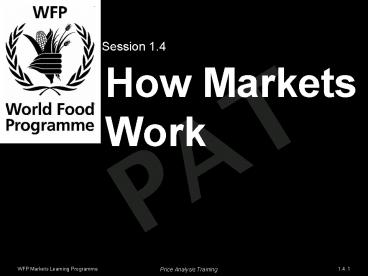How Markets Work - PowerPoint PPT Presentation
1 / 15
Title:
How Markets Work
Description:
Session 1.4 How Markets Work PAT WFP Markets Learning Programme 1.4. * Price Analysis Training Learning Objectives After this session, participants should be able to ... – PowerPoint PPT presentation
Number of Views:68
Avg rating:3.0/5.0
Title: How Markets Work
1
How Markets Work
- Session 1.4
PAT
WFP Markets Learning Programme
1.4. 1
Price Analysis Training
2
Learning Objectives
- After this session, participants should be able
to - Identify and explain the key elements of market
functioning, including market structure, conduct
and performance - Explain the relevance of structure, conduct and
performance in anticipating market response to
shocks
WFP Markets Learning Programme
1.4. 2
Price Analysis Training
3
Key elements of market analysis
- Supply understanding food production and trading
patterns (especially for most important staple
foods) - Demand factors that affect household demand
(e.g. changes in incomes, purchasing power,
preferences) - Prices levels, trends, seasonality
- and
Markets environment functioning
(structure-conduct-performance of SCP) -
factors influencing trader decisions and behaviour
WFP Markets Learning Programme
1.4. 3
Price Analysis Training
4
Why focus on SCP?
e.g. Traders plan to import cereals using prices
from regional international markets. They have
strategies for dealing with production shortfalls
in their market areas. Learning about trader
behaviors helps identify market indicators to
follow, analyze implications of market phenomena,
project likely supply responses, and ultimate
market outcomes.
- Sound SCP analysis can help
- analysts anticipate market response, define
relevant scenarios, formulate expectations about
the season to tell more complete food security
story - decision makers with info needed to make better
responses - orient timing of humanitarian response,
complementing, compensating for markets rather
than replacing them
5
Market Structure
- Refers to stable market features that influence
buyers sellers - Number of buyers sellers
- Market environment aspects public policies,
regulations, barriers to entry (e.g. license
fees, taxes, credit access, kinship ties) - Nature of trading relations vertical
coordination mechanisms (how transactions are
conducted between market participants spot
market transactions, contracts, cooperatives,
strategic alliances among farmers, traders,
transporters, processors consumers)
WFP Markets Learning Programme
1.4. 5
Price Analysis Training
6
Structure Surplus/Deficit Areas - Example
District level cereal balances in Timor Leste
(2003-2006)
WFP Markets Learning Programme
1.4. 6
Price Analysis Training
7
Structure Commodity Flows
Wheat wheat flour flows in Caucasus Region
WFP Markets Learning Programme
1.4. 7
Price Analysis Training
8
Structure Vertical Coordination/IntegrationMarke
ting Chain
WFP Markets Learning Programme
1.4. 8
Price Analysis Training
9
Structure Marketing Chain Channels
WFP Markets Learning Programme
1.4. 9
Price Analysis Training
10
Market Conduct
- The patterns of behaviour that traders follow to
affect or adjust to changing market conditions - Price-setting behaviour
- Level of competition
- Buying and selling practices
- Weights and measures
- Grades and standards
WFP Markets Learning Programme
1.4. 10
Price Analysis Training
11
Conduct Market Actors Margin Breakdown from
Rural Guinea Bissau to India
Cashew Nut Prices (FCFA)
WFP Markets Learning Programme
1.4. 11
Price Analysis Training
12
Market Performance
- Extent to which markets produce outcomes deemed
good or preferred by society regular,
predictable availability of basic foods at
affordable prices - Price levels and stability over time and space
- Margins and costs
- Volumes
- Profits excessive or not
- Product quality
- Food distribution within market
WFP Markets Learning Programme
1.4. 12
Price Analysis Training
13
Market Performance Example
Real millet prices in regions of Niger and
Nigeria, 1995 to 2006
14
Market Functioning
- The logical conclusion drawn from analysing
market structure, conduct and performance - Market functioning should not be equated simply
with market performance all three market
aspects (S-C-P) must be analysed - Understanding market structure the conduct of
traders, other actors in the market system helps
us understand how traders may respond to a shock
i.e. whether they will hoard or move
commodities when price differentials sky rocket.
WFP Markets Learning Programme
1.4. 14
Price Analysis Training
15
Application and Interpretation of S-C-P and
Market Functioning
- Helps us anticipate how the market is likely to
respond to shocks - Can help us anticipate price changes (seasonal
impacts, etc.) - Informs response decisions helps identify risks
(e.g. corruption, inflation, trader response
capacities) confronting various response options
WFP Markets Learning Programme
1.4. 15
Price Analysis Training
16
Please turn to Workbook Exercise 1.4. The
Marketastan File Market Environment in Northern
Province
Small Group Work
17
Exercise 1.4. Debriefing
- Market environment in Northern Province?
- Likely implications for market functioning and
for HH food security in Northern Province?































